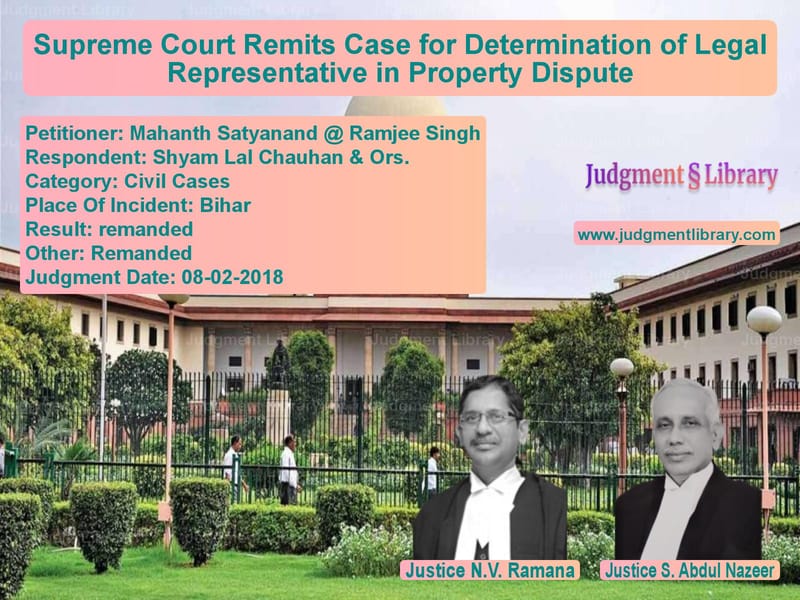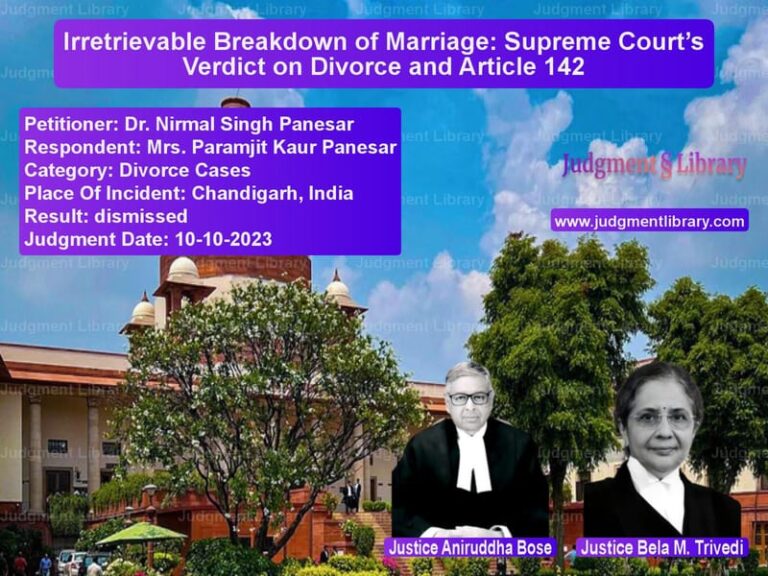Supreme Court Remits Case for Determination of Legal Representative in Property Dispute
The Supreme Court of India recently delivered its ruling in Mahanth Satyanand @ Ramjee Singh vs. Shyam Lal Chauhan & Ors., addressing a complex dispute regarding succession rights in a religious institution. The Court ruled that the High Court had erred by allowing both claimants to participate in the case without determining who was the rightful legal representative of the deceased litigant. The matter was remitted to the High Court for proper adjudication.
Background of the Case
The dispute originated from a civil suit filed by Shyam Lal Chauhan and others against Swami Sheo Dharmanand and other defendants, seeking a declaration that the defendants were trespassers and should be permanently restrained from interfering in certain temple properties. After the trial court dismissed the suit, the plaintiffs filed a first appeal, which was allowed. The defendants then appealed to the High Court.
During the pendency of the second appeal before the High Court, one of the appellants, Swami Sheo Dharmanand, passed away. Two individuals—Swami Triyoganand and Mahanth Satyanand @ Ramjee Singh—each claimed to be the rightful successor and legal representative of the deceased appellant. The High Court initially referred the matter to the trial court for a factual determination under Order 22 Rule 5 of the Civil Procedure Code (CPC). The trial court found that Mahanth Satyanand was the legal representative. However, the High Court subsequently allowed both claimants to participate in the appeal, leading to the present appeal before the Supreme Court.
Arguments Presented
Petitioners’ (Mahanth Satyanand) Arguments
- The High Court erred by permitting both rival claimants to participate in the appeal without deciding who was the legal representative of the deceased.
- Order 22 Rule 5 of CPC mandates that the court must determine a single legal representative before proceeding with the case.
- By failing to decide the matter conclusively, the High Court violated established legal principles.
Respondents’ (Swami Triyoganand) Arguments
- The High Court’s decision to allow both claimants to participate ensured fairness and protected the rights of both parties.
- The dispute involved complex religious succession questions, and a summary determination under Order 22 Rule 5 CPC was insufficient.
- The trial court’s finding was not binding on the High Court and should not be treated as final.
Supreme Court’s Ruling
A bench comprising Justice N.V. Ramana and Justice S. Abdul Nazeer ruled in favor of Mahanth Satyanand, setting aside the High Court’s order and remanding the matter for proper determination.
1. Mandatory Determination of Legal Representative
The Supreme Court emphasized that Order 22 Rule 5 CPC requires the court to determine who is the proper legal representative before proceeding with the case. The Court stated:
“The High Court, instead of deciding on merits the question of legal representative of the deceased out of the two contenders, has simply substituted both the contenders in the place of the deceased appellant before it.”
2. High Court’s Error in Allowing Both Claimants
The Court held that the High Court had failed in its duty to conclusively determine the rightful successor, observing:
“The Court cannot make all the contenders as parties. The aspect of deciding the legal representative cannot also be postponed with a view to decide the same at the time of final disposal of the appeal on merits.”
3. Remanding the Matter for Proper Adjudication
The Supreme Court directed the High Court to reconsider the trial court’s findings and decide who was the rightful legal representative. The Court stated:
“The High Court shall decide the question on merits as to who is the legal representative of the deceased Swami Sheo Dharmanand on the basis of the reports submitted by the trial court and also taking into account any objections or material which the parties rely upon.”
Key Observations
- The ruling reaffirmed that procedural laws must be followed strictly to ensure fair adjudication.
- The Court clarified that a legal representative’s role in an appeal is to represent the deceased’s interests, and a proper determination is necessary before proceeding.
- The judgment set a precedent for similar succession disputes, ensuring that courts must decide on the legal representative before proceeding with substantive issues.
Conclusion
The Supreme Court’s ruling in Mahanth Satyanand @ Ramjee Singh vs. Shyam Lal Chauhan & Ors. underscores the importance of due process in succession disputes, especially within religious institutions. By remitting the case to the High Court, the ruling ensures that procedural fairness is maintained, preventing unnecessary complications in property and succession litigation.
Petitioner Name: Mahanth Satyanand @ Ramjee SinghRespondent Name: Shyam Lal Chauhan & Ors.Judgment By: Justice N.V. Ramana, Justice S. Abdul NazeerJudgment Date: 08-02-2018
Don’t miss out on the full details! Download the complete judgment in PDF format below and gain valuable insights instantly!
Download Judgment: Mahanth Satyanand @ vs Shyam Lal Chauhan & Supreme Court of India Judgment Dated 08-02-2018.pdf
Direct Downlaod Judgment: Direct downlaod this Judgment
See all petitions in Property Disputes
See all petitions in Succession and Wills
See all petitions in Landlord-Tenant Disputes
See all petitions in Judgment by N.V. Ramana
See all petitions in Judgment by S. Abdul Nazeer
See all petitions in Remanded
See all petitions in Remanded
See all petitions in supreme court of India judgments February 2018
See all petitions in 2018 judgments
See all posts in Civil Cases Category
See all allowed petitions in Civil Cases Category
See all Dismissed petitions in Civil Cases Category
See all partially allowed petitions in Civil Cases Category







